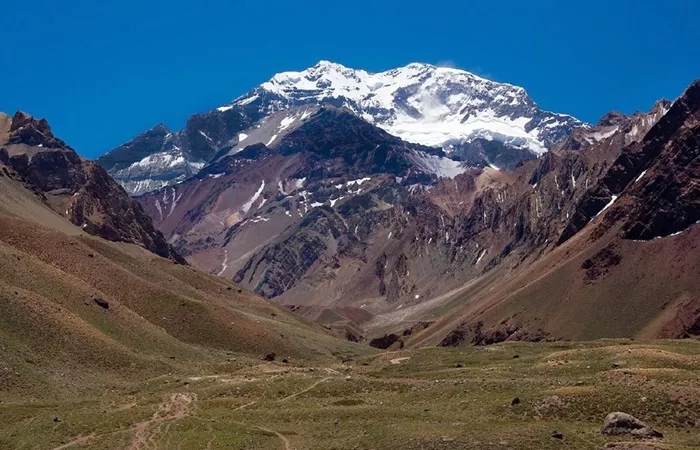Aconcagua is a mountain that has captured the imagination of adventurers, geologists, and nature enthusiasts alike. Standing tall in the Andes mountain range, it holds the distinction of being the highest peak in the Americas, the highest outside of Asia, and the highest in both the western and southern hemispheres.
The Height of Aconcagua
Aconcagua’s summit elevation is 6,961 metres (22,838 ft). This makes it a truly towering presence on the global stage. Despite its remarkable height, it ranks as only the 189th highest mountain in the world. However, its significance cannot be understated, especially within the context of the Americas and the southern hemisphere.
Geographical Location
Aconcagua is located in the Mendoza province of Argentina, in the principal cordillera of the Andes mountain range. It lies 112 kilometres (70 miles) northwest of the provincial capital, the city of Mendoza. The mountain is about five kilometres (three miles) from San Juan province and 15 km (9 mi) from Argentina’s border with Chile. It is bounded by the Valle de las Vacas to the north and east and the Valle de los Horcones Inferior to the west and south. The mountain and its surroundings are part of Aconcagua Provincial Park.
Geological History
The formation of Aconcagua is a fascinating story of plate tectonics. The mountain was created by the subduction of the Nazca plate beneath the South American plate. In the past, Aconcagua used to be an active stratovolcano. From the late Cretaceous or early Paleocene through the Miocene, it consisted of several volcanic complexes on the edge of a basin with a shallow sea.
However, around 8 to 10 million years ago, during the Miocene epoch, the subduction angle started to decrease. This led to a halt in the melting process and more horizontal stresses between the oceanic plate and the continent. As a result, thrust faults formed, lifting Aconcagua off its volcanic root.
The rocks on Aconcagua’s flanks are all volcanic in origin. They consist of lavas, breccias, and pyroclastics. The shallow marine basin that once surrounded the mountain had already formed earlier, during the Triassic period, even before Aconcagua emerged as a volcano. Volcanism has been present in this region for as long as the basin has existed, and volcanic deposits intermingle with marine deposits throughout the geological sequence.
The colorful greenish, bluish, and grey deposits seen in the Horcones Valley and south of Puente del Inca are carbonates, limestones, turbidites, and evaporates that filled the basin. The red – colored rocks are intrusions, cinder deposits, and conglomerates of volcanic origin.
Climbing Aconcagua
Mountaineering Difficulty
In mountaineering terms, Aconcagua is technically an easy mountain if approached from the north via the normal route. It is often considered the highest non – technical mountain in the world, as the northern route does not absolutely require ropes, axes, and pins. However, this does not mean it is an easy climb. The effects of altitude are severe, with atmospheric pressure at the summit being only 40% of sea level.
Although the use of supplemental oxygen is not common, altitude sickness will affect most climbers to some extent, depending on the degree of acclimatization. Despite the technical ease of the normal climb, multiple casualties occur every year on this mountain. This is due to the large number of climbers attempting the ascent and the fact that many underestimate the objective risks of the elevation and cold weather, which pose the real challenges on Aconcagua. Given the weather conditions close to the summit, cold – weather injuries are very common.
Routes to the Peak
The routes to the peak from the south and south – west ridges are more demanding, and the south face climb is considered quite difficult. The Polish Glacier traverse route, also known as the “Falso de los Polacos” route, crosses through the Vacas Valley, ascends to the base of the Polish Glacier, then traverses across to the normal route for the final ascent to the summit. The third most popular route is along the Polish Glacier itself.
Camps
There are several camps along the climbing routes. Provincial park rangers do not maintain records of successful summits, but estimates suggest a summit rate of 30 – 40%. About 75% of climbers are foreigners and 25% are Argentinean. Among foreigners, the United States leads in the number of climbers, followed by Germany and the UK.
Mythological Meaning
The origin of the name Aconcagua is uncertain. It may be from the Mapudungun “a conca – hue”, which refers to the Aconcagua River and means “comes from the other side”. Another possibility is the Quechua “ackon ca huak”, meaning “sentinel of stone”, or “anco ca huac”, meaning “white sentinel”. It could also be from the Aymara “janq’u q’awa”, meaning “white ravine”.
Conclusion
Aconcagua, with its height of 6,961 metres, is a mountain of great significance. Its geological history, shaped by plate tectonics and volcanic activity, has created a unique landscape. The challenges of climbing Aconcagua, from altitude sickness to cold – weather risks, make it a test of endurance and skill for mountaineers. Whether you are a geologist interested in its formation, a climber seeking a challenging ascent, or a nature lover admiring its beauty from afar, Aconcagua offers a wealth of experiences. Its mythological name adds an air of mystery to this already remarkable mountain, making it a subject of continued fascination and exploration.
Related topics:
How to Get into Mountain Climbing
Exploring the Pinnacle of Thrills: Best Adventure Mountain Sports

